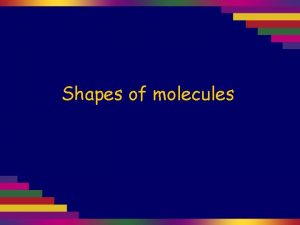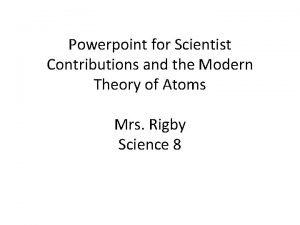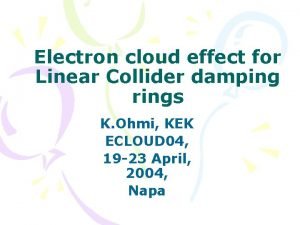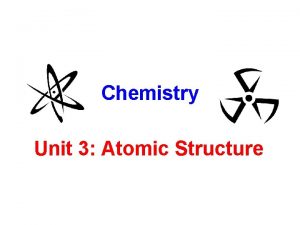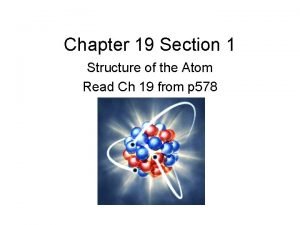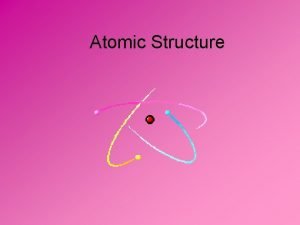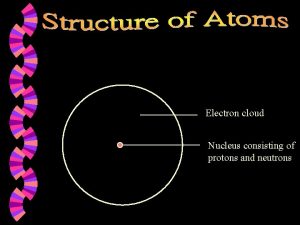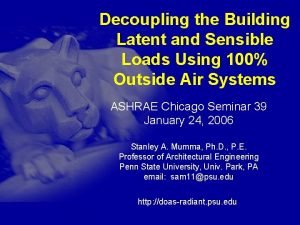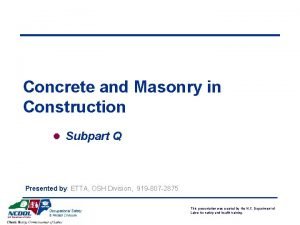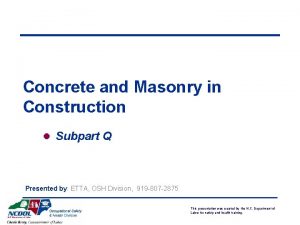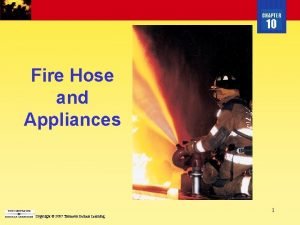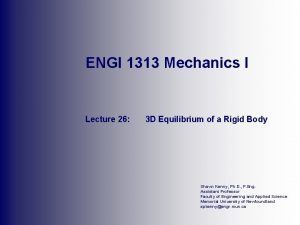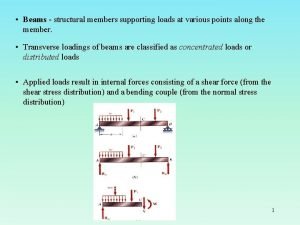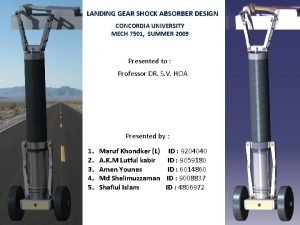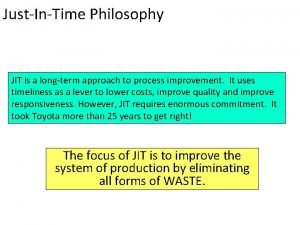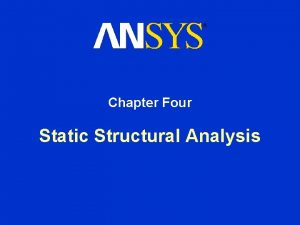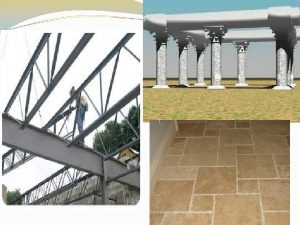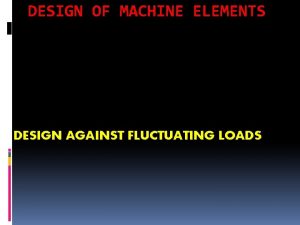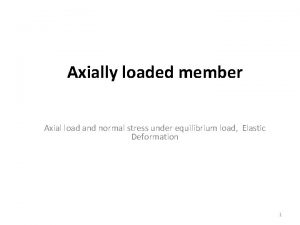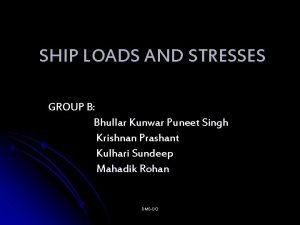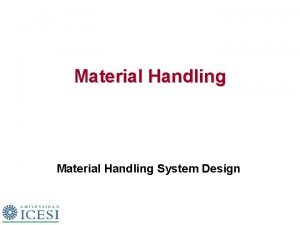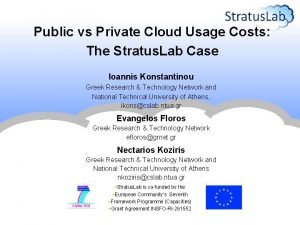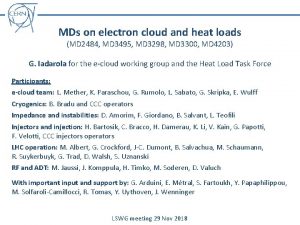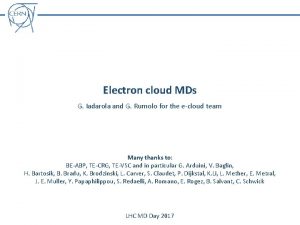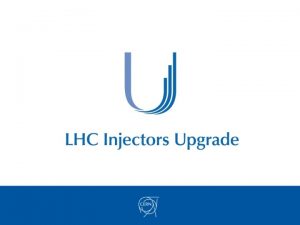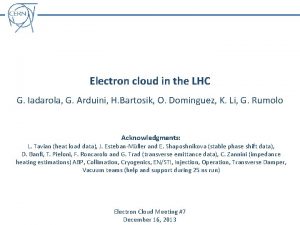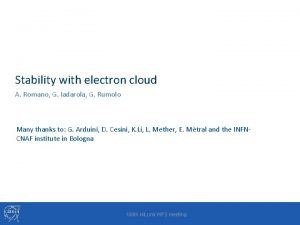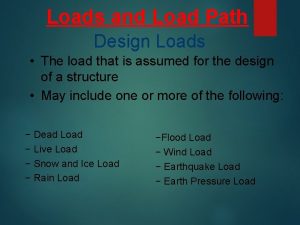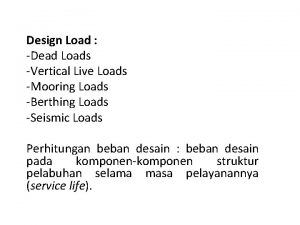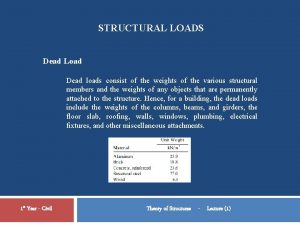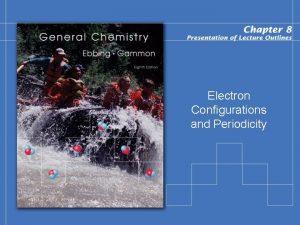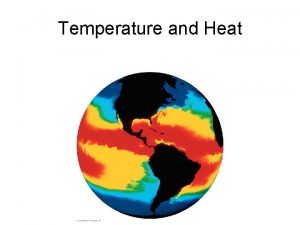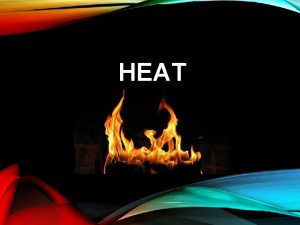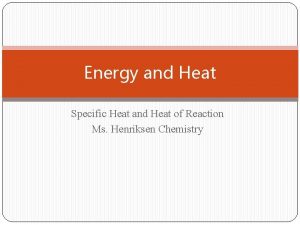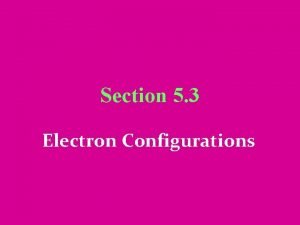Electron cloud and heat loads G Iadarola for













































![6. 5 Te. V (physics fills with >2000 b) 2016 2017 Heat load [W/hcell] 6. 5 Te. V (physics fills with >2000 b) 2016 2017 Heat load [W/hcell]](https://slidetodoc.com/presentation_image/6c4aab04331e2c1bbb875eac494e46cc/image-46.jpg)











- Slides: 57

Electron cloud and heat loads G. Iadarola for the Beam Induced Heat Load Task Force and the e-cloud Working Group With input from: G. Arduini, B. Bradu, P. Dijkstal, F. Giordano, E. Metral, L. Mether, A. Romano, G. Rumolo, V. Petit, B. Salvant, G. Skripka, M. Taborelli, L. Tavian, E. Wulff

Outline Introduction Effects on the beam • Injection energy • Top energy Heat loads • Issues, mitigation and evolution in Run 2 • Differences among the sectors • Underlying mechanism Outlook for Run 3 • Plans for LS 2 • e-cloud dependence on bunch intensity • Expected intensity reach • First thoughts on scrubbing after LS 2

Introduction Run 2 marked an important milestone with respect to e-cloud effects in the LHC, i. e. the usage of the 25 ns bunch spacing for most of the p-p physics operation o With 25 ns spacing e-cloud effects are much stronger than with 50 ns spacing (used for luminosity production in Run 1) Main lessons learnt in two points: e-cloud can be mitigated to a large extent: beam-induced scrubbing allows mitigating e-cloud effects to an extent that allows a satisfactory exploitation of 25 ns beams in physics o Scrubbing is mostly preserved over Year-End Technical Stops in regions that are not vented recovery in ~1 day of conditioning at 450 Ge. V …but it was not possible to fully get rid of it: even after years of conditioning of the beam chambers, we keep seeing: o Impact on beam quality (instabilities, losses, emittance growth) o Heat loads in cryogenic magnets (with puzzling differences among sectors)

Outline Introduction Effects on the beam • Injection energy • Top energy Heat loads • Issues, mitigation and evolution in Run 2 • Differences among the sectors • Underlying mechanism • Run 1 vs Run 2 Outlook for Run 3 • Plans for LS 2 • e-cloud dependence on bunch intensity • Expected intensity reach • First thoughts on scrubbing after LS 2

Beam degradation at 450 Ge. V: the first impression At the very beginning of Run 2 it was quite difficult to get the beams under control: • Violent e-cloud instabilities causing severe losses even with short bunch trains • Beams could be stabilized only after several days of scrubbing Scrubbing at 450 Ge. V - day 3(*) Right after injection 10 min after injection (*) Major 24 b faults, tests and commissioning activities are subtracted from day counting

Beam degradation at 450 Ge. V: the first impression At the very beginning of Run 2 it was quite difficult to get the beams under control: • Violent e-cloud instabilities causing severe losses even with short bunch trains • Beams could be stabilized only after several days of scrubbing Scrubbing at 450 Ge. V - day 7(*) Right after injection 10 min after injection (*) Major 48 b faults, tests and commissioning activities are subtracted from day counting

Beam degradation at 450 Ge. V: the first impression At the very beginning of Run 2 it was quite difficult to get the beams under control: • Violent e-cloud instabilities causing severe losses even with short bunch trains • Beams could be stabilized only after several days of scrubbing Scrubbing at 450 Ge. V - day 8(*) Right after injection 10 min after injection (*) Major 72 b faults, tests and commissioning activities are subtracted from day counting

Beam degradation at 450 Ge. V: the first impression At the very beginning of Run 2 it was quite difficult to get the beams under control: • Violent e-cloud instabilities causing severe losses even with short bunch trains • Beams could be stabilized only after several days of scrubbing Scrubbing at 450 Ge. V - day 9(*) Right after injection 10 min after injection (*) Major 144 b faults, tests and commissioning activities are subtracted from day counting

Beam degradation at 450 Ge. V: the first impression At the very beginning of Run 2 it was quite difficult to get the beams under control: • Violent e-cloud instabilities causing severe losses even with short bunch trains • Beams could be stabilized only after several days of scrubbing Scrubbing at 450 Ge. V - day 12(*) Right after injection 10 min after injection (*) Major 144 b faults, tests and commissioning activities are subtracted from day counting

Beam degradation at 450 Ge. V: beam stability • Still, during all Run 2, to stabilize 25 ns beams we needed to use high chromaticity (Q’xy >15) and high octupole currents (Ioct > 50 A), high feedback gain and bandwidth • To preserve lifetime, we needed to optimize tunes at injection to better accommodate large tune footprint • Beam still not fully stable weak instabilities leading to some blow-up on a small fraction of bunches occurred in most of the physics fills Py. ECLOUD-Py. HEADTAIL sim. Emittances at start-ramp for a typical 2018 fill A. Romano More details on injection instabilities in presentation by X. Buffat

Beam degradation at 450 Ge. V: slow-degradation • Even when the beam is kept stable the e-cloud causes a slow beam degradation (losses and emittance blow-up) o Particularly visible when the beam is stored some time at 450 Ge. V Test conducted in 2018 Right after injection 0. 5 h after injection More details in presentation by S. Papadopulou

Beam degradation at 450 Ge. V: slow-degradation • Even when the beam is kept stable the e-cloud causes a slow beam degradation (losses and emittance blow-up) o Particularly visible when the beam is stored some time at 450 Ge. V Test conducted in 2018 Right after injection 1. 0 h after injection More details in presentation by S. Papadopulou

Beam degradation at 450 Ge. V: slow-degradation • Even when the beam is kept stable the e-cloud causes a slow beam degradation (losses and emittance blow-up) o Particularly visible when the beam is stored some time at 450 Ge. V Test conducted in 2018 Right after injection 1. 5 h after injection More details in presentation by S. Papadopulou

Beam degradation at 450 Ge. V: slow-degradation • Even when the beam is kept stable the e-cloud causes a slow beam degradation (losses and emittance blow-up) o Particularly visible when the beam is stored some time at 450 Ge. V Test conducted in 2018 Right after injection 2. 0 h after injection More details in presentation by S. Papadopulou

Effects on beam dynamics: 6. 5 Te. V Thanks to the increased beam rigidity, effects of the e-cloud on the beam dynamics are much weaker at 6. 5 Te. V but still clearly visible e-cloud pattern observed on losses during the squeeze and in collision B 1, fill 7236 More details in presentation by S. Kostoglou

Outline Introduction Effects on the beam • Injection energy • Top energy Heat loads • Issues, mitigation and evolution in Run 2 • Differences among the sectors • Underlying mechanism Outlook for Run 3 • Plans for LS 2 • e-cloud dependence on bunch intensity • Expected intensity reach • First thoughts on scrubbing after LS 2

Heat loads on the arc beam-screens • Electrons deposit energy on the beam screens of the LHC arc magnets Heat load that needs to be absorbed by the cryogenics system For some sectors at the limit of the design cooling capacity (160 W/half-cell) • Large differences observed among sectors: unexpected! Object of investigation by dedicated inter-departmental task force Cooling circuit (He, 5 -20 K) Fill 4485 (Oct 2015) 25 ns, 1825 b, 72 b-trains, 1. 15 e 11 p/bunch LHC main dipole Beam screens Avg. per half cell

Heat loads: encountered issues and mitigation Mainly two types of issues encountered during Run 2: 1. Heat load transients (injection, ramp, beam-dump) too large excursions of beam screen temperatures leading to loss of cryo-conditions. Mitigated by: Relaxed Cryo. Maintain rules to allow for larger transient (after careful review, moved from “T>30 K for 30 s” to “T>40 K for 30 min”, see LMC#236) Developed and optimized cryogenic feed-forward to anticipate transients based on measured beam properties (see LMC#257) More details in presentation by G. Ferlin TE-CRG, BE-ICS

Heat loads: encountered issues and mitigation Mainly two types of issues encountered during Run 2: 2. Total load on the cryoplants close to the design limit (especially in 2015 when chambers were not fully conditioned). Mitigated by: Profiting from flexibility in filling scheme design Filling schemes used in Run 2

Heat loads: encountered issues and mitigation Mainly two types of issues encountered during Run 2: 2. Total load on the cryoplants close to the design limit (especially in 2015 when chambers were not fully conditioned). Mitigated by: Never accelerated to 6. 5 Te. V Profiting from flexibility in filling scheme design with full number of bunches Filling schemes used in Run 2

Heat loads: encountered issues and mitigation Mainly two types of issues encountered during Run 2: 2. Total load on the cryoplants close to the design limit (especially in 2015 when chambers were not fully conditioned). Mitigated by: First physics fills with >2000 b Profiting from flexibility in filling scheme design in 2015 (with machine not fully conditioned) Filling schemes used in Run 2

Heat loads: encountered issues and mitigation Mainly two types of issues encountered during Run 2: Used for lumi production in 2016 -2018: 2. Total load on the cryoplants close to the design limit (especially in 2015 when - Max. n. bunches only slightly smaller chambers were not fully conditioned). Mitigated by: than standard scheme (-7 %) Profiting from flexibility in filling scheme design + Lower heat load + Higher brightness from the injectors Filling schemes used in Run 2 +

Heat loads: encountered issues and mitigation Mainly two types of issues encountered during Run 2: 2. Total load on the cryoplants close to the design limit (especially in 2015 when chambers were not fully conditioned). Mitigated by: Conditioning accumulated parasitically during physics operation Reduction observed in 2015 -16 but not later on Total heat loads directly affected LHC performance only in 2015. In the following years intensity reach was always limited by other factors (SPS dump in 2016, 16 L 2 in 2017 -18) 25 ns physics fills with >600 b 2015 2016 2017 2 S 1 ted n ve 2018

Heat loads: differences among sectors • Heat loads in S 12, S 23, S 81 much larger than for the other sectors close to cryo-plant design capacity • These differences are very reproducible and were observed in all 25 ns fills over 4 years (2015 -18) 25 ns physics fills with >600 b 2015 2016 2017 2 S 1 ted n ve 2018

Heat loads: differences among sectors • Heat loads in S 12, S 23, S 81 much larger than for the other sectors close to cryo-plant design capacity • These differences are very reproducible and were observed in all 25 ns fills over 4 years (2015 -18) • But differences were not present in Run 1: High load sectors experienced a degradation between Run 1 and Run 2(1) 2012 (25 ns test, end of the run) 2018 (25 ns, during scrubbing) Trains of 288 b Avg. per half cell (1) It is possible to show that it is not a measurement artefact. For more details see presentations at LMC#360

Heat loads: distribution along the ring • Especially in the high load sectors, we observe large differences from cell to cell • Heat loads can be different for the two apertures of the same cell • Differences are present even among magnets of the same cell Sector 12 (MD 2018) B 1 alone B 2 alone B 1&B 2 Cell 31 L 2 (equipped with extra thermometers) At 450 Ge. V: 25 W 20 W 50 W At 6. 5 Te. V: 3 W Q Dipole 5 W 30 W 70 W 8 W

Heat loads: distribution along the ring • • Especially in the high load sectors, we observe large differences from cell to cell Heat loads can be different for the two apertures of the same cell Differences are present even among magnets of the same cell Technique being developed to localize heat source within the magnet (based on temperature evolution at the beam dump) Tricky in the absence of a direct measurement of the helium flow Accuracy will improve with the installation of flow-meters during LS 2 Automatically generated at each beam dump. B. Bradu (TE-CRG) Calculation results available at: http: //cryodataanalytics. web. cern. ch/Cryo. Data. Analytics/Qdistrib/

Outline Introduction Effects on the beam • Injection energy • Top energy Heat loads • Issues, mitigation and evolution in Run 2 • Differences among the sectors • Underlying mechanism Outlook for Run 3 • Plans for LS 2 • e-cloud dependence on bunch intensity • Expected intensity reach • First thoughts on scrubbing after LS 2

Heat loads: underlying mechanisms How do we know that the heating source is the e-cloud? • We reviewed the mechanisms that can transfer energy from the beam to the beam-screen and evaluated their compatibility with observations Beam Observations = Excluded For more details see presentations at LMC#358 and ABP Forum Beam screen e-/ions in the pipe Measured dependence on bunch intensity is not linear nor quadratic Electromagnetic coupling Heat loads with 50 ns are >10 times smaller than with 25 ns Radiation (synchrotron radiation) Heat load increases only moderately during the energy ramp Beam particles (losses) Total power associated to intensity loss is less than 10% of measured heat load

Heat loads: underlying mechanisms How do we know that the heating source is the e-cloud? • We reviewed the mechanisms that can transfer energy from the beam to the beam-screen and evaluated their compatibility with observations Beam Observations We try reproduce the observations with e-cloud simulations Heat loads with 50 ns are >10 times smaller than with 25 ns Measured dependence on bunch intensity is not linear nor quadratic = Excluded For more details see presentations at LMC#358 and ABP Forum Beam screen e-/ions in the pipe Heat load increases only moderately during the energy ramp e-cloud effects are not incompatible with any of the observations Electromagnetic coupling Radiation (synchrotron radiation) Beam particles (losses) Total power associated to intensity loss is less than 10% of measured heat load

Heat loads: underlying mechanisms How do we know that the heating source is the e-cloud? • We reviewed the mechanisms that can transfer energy from the beam to the beam-screen and evaluated their compatibility with observations …we attribute the differences in heat load to different Secondary Electron Yield (SEY) 1. 35 S 45 S 34 1. 25 1. 15 Through e-/ions in the pipe 1. 35 Beam Electromagnetic coupling S 81 Radiation (synchrotron radiation) S 12 Beam particles (losses) Based on heat load Sector Observations measurements taken with SEYmax 25 ns, 6. 5 Te. V, 1. 1 e 11 p/b Total power associated to intensity loss is less than 10% than measured heat load The inferred values could be validated using several independent machine observations (50 ns, 8 b+4 e, injection vs high energy, different bunch intensities) Heat load increases only moderately during the energy ramp Heat loads with 50 ns are >10 times Good agreement smaller than with 25 ns especially for high-load Measured dependence on bunch sectors intensity is not linear nor quadratic G. Skripka For more details see presentations = Excluded at e-cloud meeting #62 For more details see presentations at LMC#358 and ABP Forum Beam screen

Heat loads: underlying mechanisms How do we know that the heating source is the e-cloud? • We reviewed the mechanisms that can transfer energy from the beam to the beam-screen and evaluated their compatibility with observations Beam Observations ✓= Good quantitative agreement (assuming different SEY per sector) = Excluded For more details see presentations at LMC#358 and ABP Forum Beam screen N. A. e-cloud Measured dependence on bunch intensity is not linear nor quadratic Electromagnetic coupling Heat loads with 50 ns are >10 times smaller than with 25 ns Radiation (synchrotron radiation) Heat load increases only moderately during the energy ramp Beam particles (losses) Total power associated to intensity loss is less than 10% of measured heat load ✓ ✓ ✓

Heat loads: ongoing surface studies • Laboratory measurement campaign launched by TE-VSC to investigate possible causes of SEY alterations: o Analysis and tests on beam screens extracted from the LHC in 2016 -17 (MB -A 31 L 2) o Several alteration processes simulated and studied in lab experiments • History of beam screen manufacturing, installation and operation is being analyzed to try to identify possible causes of degradation o No smoking gun found so far… Chemical alterations following beam operation Effect of impurities from cleaning product Cu. O V. Petit, M. Taborelli (TE-VSC) For more details see presentation at LMC#360

Outline Introduction Effects on the beam • Injection energy • Top energy Heat loads • Issues, mitigation and evolution in Run 2 • Differences among the sectors • Underlying mechanism Outlook for Run 3 • Plans for LS 2 • e-cloud dependence on bunch intensity • Expected intensity reach • First thoughts on scrubbing after LS 2

Heat loads: plans for LS 2 • A different gas composition will be used for the venting of the arc beam vacuum system well controlled and reproducible exposure procedure • High-load magnet MB-B 31 L 2 will be removed from the tunnel and will undergo extensive surface analysis. Comparison will be made with a low-load magnet. • New cryogenic instrumentation will be installed during LS 2: o After LS 2 we will have 10 instrumented cells (including present 4, which will be upgraded) better heat load localization o Global sector load measurements on four sectors (S 12, S 23, S 56, S 67) • BE-BI will continue the development of microwave measurement technique for direct e-cloud density measurements Sector cold flow-meter (QUI) Arc-cell cold flow-meters For more details see presentations by L. Tavian at LMC#360

Outline Introduction Effects on the beam • Injection energy • Top energy Heat loads • Issues, mitigation and evolution in Run 2 • Differences among the sectors • Underlying mechanism Outlook for Run 3 • Plans for LS 2 • e-cloud dependence on bunch intensity • Expected intensity reach • First thoughts on scrubbing after LS 2

Dependence of e-cloud heat loads on bunch intensity • Higher bunch intensity will become available from the injectors during Run 3 • With the available models, simulations foresee a relatively mild increase of the heat load from e-cloud above 1. 2 x 1011 p/bunch • Direct experimental checks were not possible in Run 2 (RF limitations in the SPS) • At end 2018, trains of 12 b with high bunch intensity became available from the SPS Tests done during LHC MD 4 confirmed ~flat dependence above 1. 5 x 1011 p/b! Model (SEY = 1. 35) 2748 b, 48 b scheme Bunch intensity [1011 p/bunch] Experimental data (MD 2018) Heat load from e- cloud [W/half-cell] Impedance Synch. rad. Heat load [k. W/arc] e-cloud in dipoles e-cloud in quadrup. e-cloud in drifts 1020 b, 12 b scheme Bunch intensity [1011 p/bunch]

Dependence of e-cloud heat loads on bunch intensity • Higher bunch intensity will become available from the injectors during Run 3 • With the available models, simulations foresee a relatively mild increase of the heat load from e-cloud above 1. 2 x 1011 p/bunch • Direct experimental checks were not possible in Run 2 (RF limitations in the SPS) • Quantitative agreement of experimental data against simulations is very • At end 2018, trains of 12 b with high bunch intensity became available from the SPS good especially for high-load sectors Tests done during LHC MD 4 confirmed ~flat dependence above 1. 5 x 1011 p/b! Model (SEY = 1. 35) Impedance Synch. rad. G. Skripka and E. Wulff 2748 b, 48 b scheme Bunch intensity [1011 p/bunch] Experimental data (MD 2018) Heat load from e- cloud [W/half-cell] Heat load [k. W/arc] e-cloud in dipoles e-cloud in quadrup. e-cloud in drifts For more details see presentation at e-cloud meeting #62 1020 b, 12 b scheme Bunch intensity [1011 p/bunch]

Expectations for Run 3 • Counting only on the nominal cooling capacity (160 W/hcell) the bunch intensity would be limited ~1. 3 x 1011 p/bunch • Actual capacity of the cryoplants was assessed with measurements by TE-CRG In the most critical sectors (S 12, S 23 and S 81) we can count on ~200 W/hcell 1. 8 e 11 p/bunch should be within reach (with no margin)! • In case of problems (further degradation during LS 2, lower cryo performance) heat loads can be mitigated using “mixed filling schemes” (8 b 4 e inserts in 25 ns beams) Heat load [k. W/arc] SEY = 1. 35 (S 12 and S 81) (*) e-cloud in dipoles e-cloud in quadrupoles e-cloud in drifts Impedance Synchrotron rad. 10 k. W/arc (~200 W/hc) 8 k. W/arc (~160 W/hc) (*) Assuming 2748 b, 48 b scheme Bunch intensity [1011 p/bunch] that after scrubbing the SEY for the critical sectors will be the same as in Run 2 (as for 2016 -17 thermal cycle in S 12) For more details see presentation at Run 3 config meetings (#2 and #4)

Outline Introduction Effects on the beam • Injection energy • Top energy Heat loads • Issues, mitigation and evolution in Run 2 • Differences among the sectors • Underlying mechanism Outlook for Run 3 • Plans for LS 2 • e-cloud dependence on bunch intensity • Expected intensity reach • First thoughts on scrubbing after LS 2

Scrubbing at the beginning of Run 3 • The main goal is to mitigate instabilities and beam degradation • Heat load mitigation can be completed parasitically with 25 ns physics • We expect that arc conditioning will be lost during LS 2 2021 similar to 2015 In 2015 we needed ~16 scrubbing days to allow operation with 25 ns beams [50 ns] 24 36 48 60 72 Train length 144 b Major faults, tests and commissioning activities are removed from this timeline. Issues limiting scrubbing pace in 2015 have been mitigated during Run 2 / LS 2: Observed issue (2015) Mitigation deployed in Run 2 / LS 2 Vacuum spikes in the TDI - New design (TDIS) to be installed in LS 2 Outgassing in MKI areas - Pumping speed upgraded during Run 2 - Coated alumina tubes in some of the modules Beam-screen temperature transients - Cryo-condition rules relaxed during LS 2 - Improved feedforward Transverse instabilities - More margin in Q’ and octupoles (optimized tunes) We expect to be more efficient Less time should be required in 2021 (if no surprises)

Summary • Scrubbing allowed mitigating to a large extent the detrimental effects of e-cloud enabling the exploitation of 25 ns beams for luminosity production • … but e-cloud effects could not be fully suppressed and continued affecting beam stability and slow beam parameter evolution during the entire Run 2 • Electrons caused large heat loads on the cryogenics cooling system o Partially mitigated by optimizing the filling scheme and by the parasitic conditioning accumulated during physics fills • Large differences in heat-load are observed among sectors. We know that: o They were not present during Run 1 (even with 25 ns) o e-cloud is the only identified effect compatible with observations, assuming some surface modification took place in LS 1 being followed-up with lab studies • During LS 2: beam-screens will be extracted analyzed, new instrumentation will be installed and precautions will be taken to avoid further degradation • Dependence of e-cloud on bunch intensity was probed experimentally with short trains up to 1. 9 e 11 p/b trend was found to be consistent with models o Assuming no further degradation in LS 2 and counting on cryo-plants performing better than design (as measured): 1. 8 e 11 p/bunch could be within reach for Run 3

Thanks for your attention!

Heat loads: observations with 50 ns • With 50 ns beams all sectors agree very well with impedance and synchrotron radiation estimates • Differences among sectors are observed only with 25 ns, even with very small number of bunches Impossible to explain the observations as a measurement artefact (the measurement system “does not know” about the bunch spacing…) 25 ns, 313 b 50 ns, 1452 b Avg. per half cell

Inferred SEYmax range Hypothesis: we attribute the differences among sectors to differences in SEYmax first estimate made comparing the average arc loads against simulations Sector S 12 S 81 S 45 S 34 SEYmax 1. 35 1. 25 1. 15 Simulations 6. 5 Te. V For details see: P. Dijkstal et al. , CERN-ACC-NOTE-2017 -0057 Measurements 450 Ge. V 6. 5 Te. V
![6 5 Te V physics fills with 2000 b 2016 2017 Heat load Whcell 6. 5 Te. V (physics fills with >2000 b) 2016 2017 Heat load [W/hcell]](https://slidetodoc.com/presentation_image/6c4aab04331e2c1bbb875eac494e46cc/image-46.jpg)
6. 5 Te. V (physics fills with >2000 b) 2016 2017 Heat load [W/hcell] Bun. Intensity [p/bunch] N. bun. 2015 Fill number 2018

Not calibrated

MD 2484 - high intensity 8 b+4 e First comparisons against simulations (made assuming uniform SEY in the arcs) • Good agreement especially in sectors with higher load • Next step is to test more complex model where we assume that “degradation” is concentrated in the dipoles G. Skripka

MD 2484 - high intensity 8 b+4 e First comparisons against simulations (made assuming uniform SEY in the arcs) • Good agreement especially in sectors with higher load • Next step is to test more complex model where we assume that “degradation” is concentrated in the dipoles G. Skripka

MD 4203 - intensity scan with trains of 12 b at 450 Ge. V First comparisons against simulations (made assuming uniform SEY in the arcs) • Good agreement especially in sectors with higher load • Next step it to test more complex model where we assume that “degradation” is concentrated in the dipoles G. Skripka, E. Wulff

MD 4203 - intensity scan with trains of 12 b at 450 Ge. V First comparisons against simulations (made assuming uniform SEY in the arcs) • Good agreement especially in sectors with higher load • Next step it to test more complex model where we assume that “degradation” is concentrated in the dipoles G. Skripka, E. Wulff

Expectations for Run 3 Cooling capacity of the 8 cryoplants was assessed with measurements by TE-CRG Assumed for Run 3 In the most critical sectors (S 12, S 23, S 81) we can count on a cooling capacity significantly larger than nominal SEY = 1. 35 (S 12 and S 81) e-cloud in dipoles Impedance e-cloud in quadrupoles Synchrotron rad. e-cloud in drifts Assuming that after scrubbing the arc SEY will be the same as in Run 2 (as happened in 2016 -18 thermal cycle) Additional margin in cooling capacity will should allow us to exploit larger than nominal bunch intensity when available from the injectors 10 k. W/arc (~200 W/hcell) 8 k. W/arc (~160 W/hc)

Underlying mechanism We are looking for a mechanism that transfers energy from the beam to the beam-screen: • Here are the possibilities that were identified Beam losses Power associated to proton losses (including deposition on collimators!) is less than 10% of the heat load on the arc beam screens = Excluded Through e-/ions in the pipe Avg. per half cell Electromagnetic coupling Pcryo = 18 k. W Radiation (synchrotron radiation) Plosses= Lrate Eprot= 1. 4 k. W Beam particles (losses) Compatible with measured intensity loss Beam screen More info here

Underlying mechanism We are looking for a mechanism that transfers energy from the beam to the beam-screen: • Here are the possibilities that were identified Electromagnetic coupling Longitudinal Normalized impedance beam spectrum Compatible with measured dependence on beam energy Observed: More details: F. Giordano and B. Salvant, presentation at Electron Cloud Meeting (link) = Excluded Through e-/ions in the pipe Compatible with measured dependence Expected: on bunch intensity Electromagnetic coupling f 0 = revolution frequency Compatible with measured dependence on bunch spacing Beam particles (losses) Compatible with measured intensity loss Radiation (synchrotron radiation) Bunch intensity Beam screen More info here

Underlying mechanism We are looking for a mechanism that transfers energy from the beam to the beam-screen: • Here are the possibilities that were identified Electromagnetic coupling Longitudinal Normalized impedance beam spectrum = Excluded Beam screen Through e-/ions in the pipe Observed dependence is not quadratic! Electromagnetic coupling Compatible with measured dependence Avg. per half cell on bunch spacing (MD 2018) Beam particles (losses) Compatible with measured intensity loss Radiation (synchrotron radiation) Bunch intensity Beam

Underlying mechanism We are looking for a mechanism that transfers energy from the beam to the beam-screen: • Here are the possibilities that were identified Electromagnetic coupling Longitudinal Normalized impedance beam spectrum = Excluded Through e-/ions in the pipe Observed dependence is not quadratic! Electromagnetic coupling Compatible with measured dependence Zoom on bunch spacing Beam particles (losses) Compatible with measured intensity loss Radiation (synchrotron radiation) Bunch intensity Beam screen More info here

50 ns beam ~1400 bunches 1. 7 x 1011 p/b 25 ns beam ~2800 bunches 1. 15 x 1011 p/b Doublet beam ~900 doublets 0. 7 x 1011 p/b Py. ECLOUD simulations for the LHC arc dipoles
 Electron cloud shape
Electron cloud shape Surrounds the nucleus
Surrounds the nucleus Electron cloud configuration
Electron cloud configuration Electron cloud model scientist
Electron cloud model scientist Electron cloud rings
Electron cloud rings Electron cloud model
Electron cloud model Electron cloud model
Electron cloud model Mass and matter
Mass and matter Calcium bohr model
Calcium bohr model Calcium electron cloud
Calcium electron cloud Latent loads
Latent loads Forms and shores must not be removed until
Forms and shores must not be removed until Employers must not place construction loads
Employers must not place construction loads Dutchman fire hose fold
Dutchman fire hose fold Sana altaf
Sana altaf The pipe assembly supports the vertical loads shown
The pipe assembly supports the vertical loads shown The structural members supporting loads at various points.
The structural members supporting loads at various points. Archimedes principle
Archimedes principle It is acceptable to ride concrete buckets
It is acceptable to ride concrete buckets Shock absorber design
Shock absorber design Just-in-time philosophy
Just-in-time philosophy Static structural analysis in ansys workbench
Static structural analysis in ansys workbench Members used to carry wall loads over wall openings
Members used to carry wall loads over wall openings Goodman method for combination of stresses
Goodman method for combination of stresses A building bent deflects in the way same as a:-
A building bent deflects in the way same as a:- Axially loaded members
Axially loaded members Ship loads
Ship loads Unit load adalah
Unit load adalah Types of hose folding
Types of hose folding Latent heat problems
Latent heat problems Pods aggregation and silos in cloud computing
Pods aggregation and silos in cloud computing Cloud integration patterns
Cloud integration patterns Public cloud vs private cloud cost analysis
Public cloud vs private cloud cost analysis Share data
Share data Thermal capacity
Thermal capacity Moist heat cooking examples
Moist heat cooking examples Iso 22301 utbildning
Iso 22301 utbildning Typiska novell drag
Typiska novell drag Nationell inriktning för artificiell intelligens
Nationell inriktning för artificiell intelligens Vad står k.r.å.k.a.n för
Vad står k.r.å.k.a.n för Varför kallas perioden 1918-1939 för mellankrigstiden?
Varför kallas perioden 1918-1939 för mellankrigstiden? En lathund för arbete med kontinuitetshantering
En lathund för arbete med kontinuitetshantering Särskild löneskatt för pensionskostnader
Särskild löneskatt för pensionskostnader Tidbok yrkesförare
Tidbok yrkesförare Sura för anatom
Sura för anatom Densitet vatten
Densitet vatten Datorkunskap för nybörjare
Datorkunskap för nybörjare Tack för att ni lyssnade bild
Tack för att ni lyssnade bild Tes debattartikel
Tes debattartikel För och nackdelar med firo
För och nackdelar med firo Nyckelkompetenser för livslångt lärande
Nyckelkompetenser för livslångt lärande Påbyggnader för flakfordon
Påbyggnader för flakfordon Tryck formel
Tryck formel Offentlig förvaltning
Offentlig förvaltning Kyssande vind
Kyssande vind Presentera för publik crossboss
Presentera för publik crossboss Teckenspråk minoritetsspråk argument
Teckenspråk minoritetsspråk argument Plats för toran ark
Plats för toran ark
